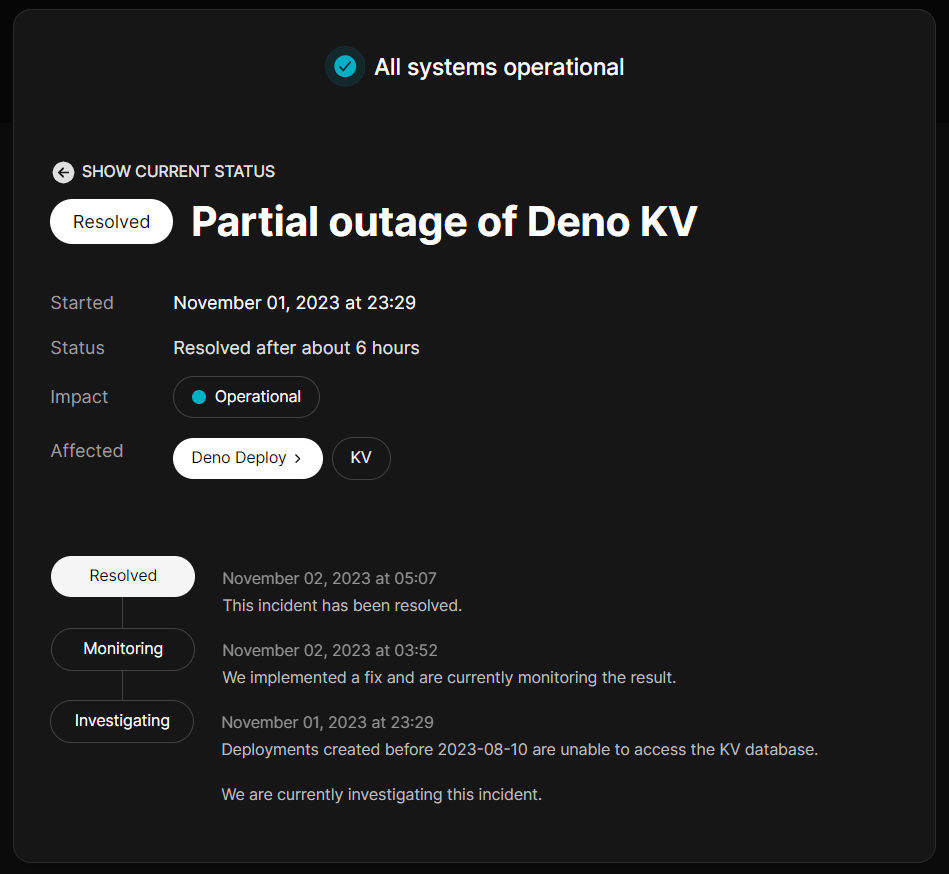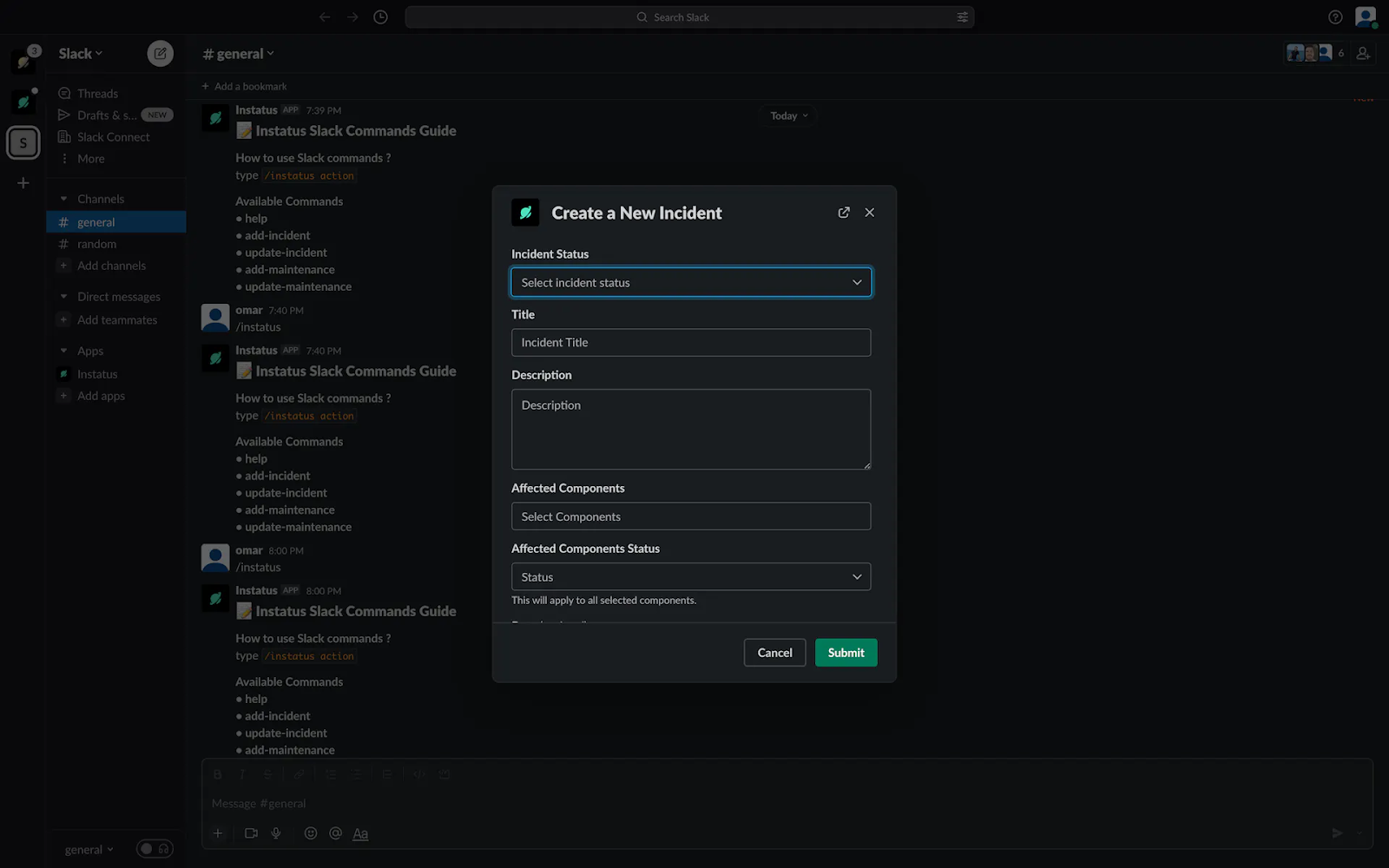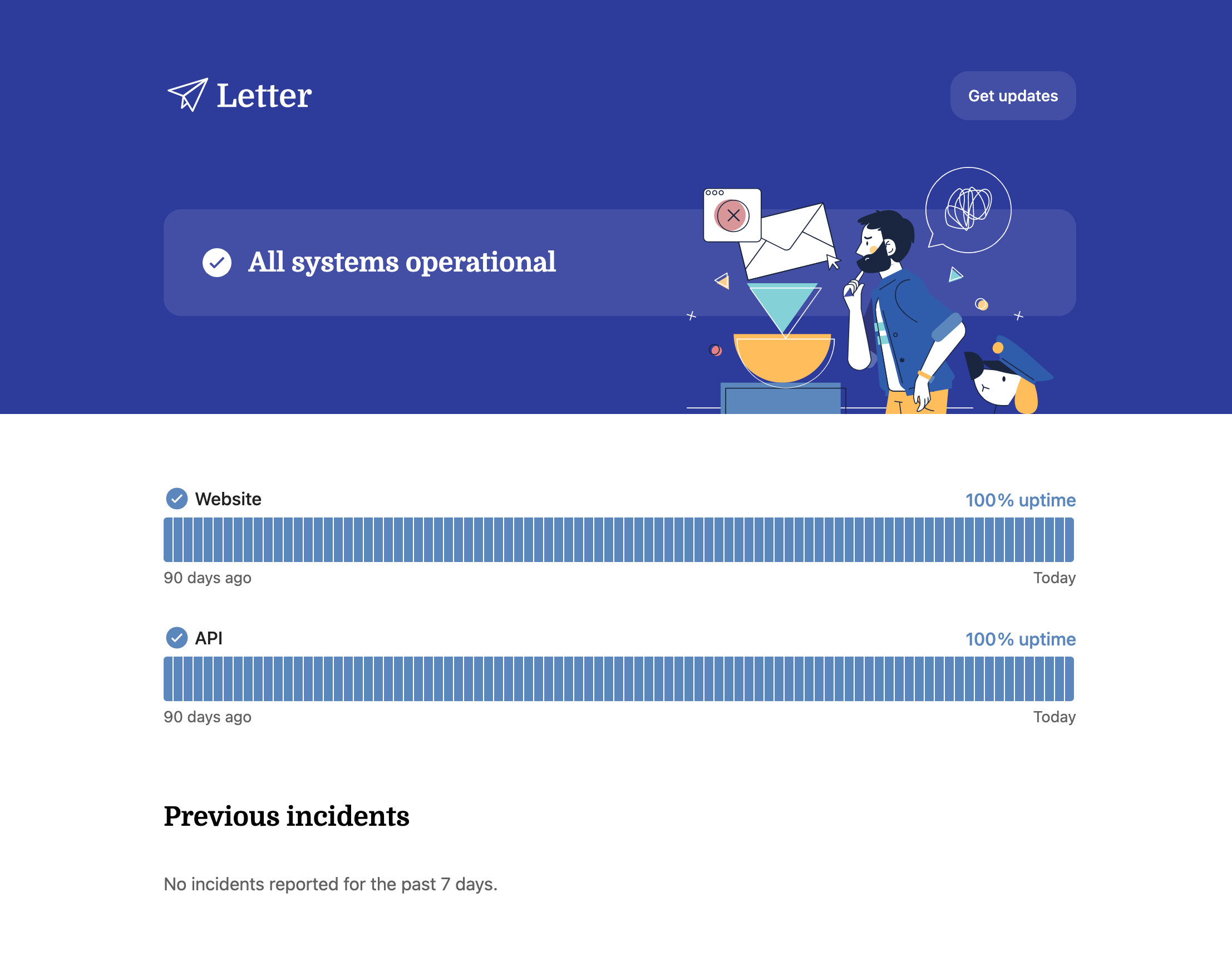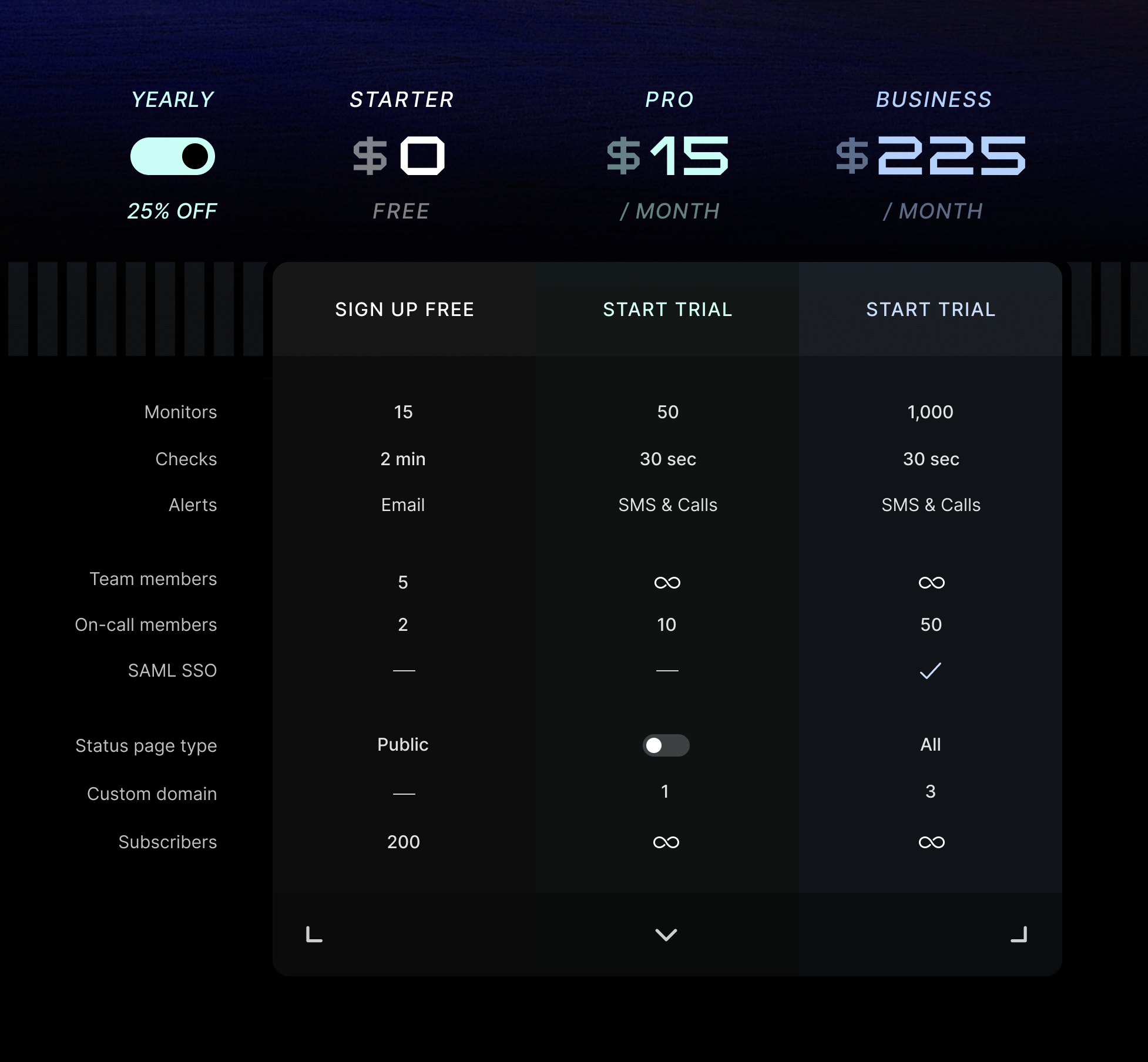Testing 8 Top Rated Uptime Kuma Alternatives: Our Comprehensive Guide

Have you ever found yourself in a frantic rush to update your customers during an unexpected system downtime, all while trying to fix the technical issue at hand? Uptime Kuma offers a potential solution. However, it does come with its own set of emerging flaws and concerns.
This article is here to help you out. We've handpicked some great alternatives for you to consider. Just imagine having a robust tool (like Instatus!) that not only keeps you updated on your system's status but also actively engages with your customers, saving you from drowning in a sea of support tickets. Now, that's truly priceless.
To discover more about the array of alternatives to Uptime Kuma, read on!
What Is Uptime Kuma?
Uptime Kuma is an open-source monitoring tool that helps you keep track of the health of your applications, websites, and APIs.
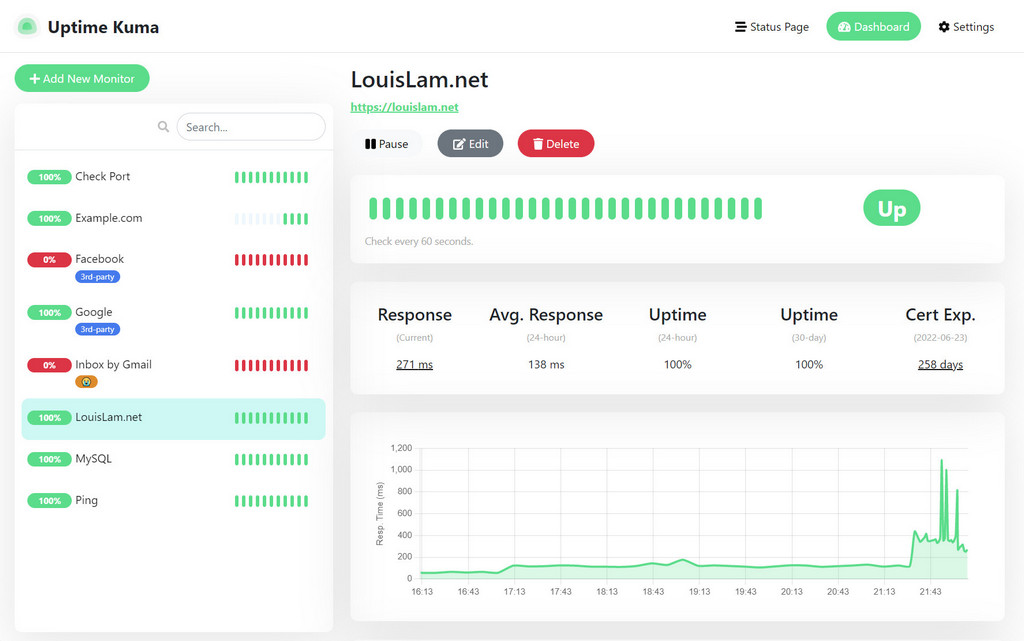
With Uptime Kuma, you can monitor services over various protocols like HTTP/S, TCP, and DNS. It provides notification alerts for downtime and allows you to create custom status pages for your users. This self-hosted monitoring service offers different types of health checks and email notifications to help you promptly address any problems that arise.
Why Look For Uptime Kuma Alternatives?
While Uptime Kuma may be useful for some businesses, it does have its drawbacks.
- Missing Functionality: Users have expressed that Uptime Kuma is lacking certain capabilities they require, such as compatibility with specific monitoring protocols and integration with other services.
- Complicated Setup: Setting up Uptime Kuma can prove to be demanding, particularly for users with limited technical expertise.
- Inadequate Performance: Certain users have encountered performance issues with Uptime Kuma, including sluggish loading times and frequent periods of unavailability.
- Insufficient Support: As a project supported by the community, Uptime Kuma offers limited official assistance.
Criteria to Consider When Looking for Uptime Kuma Alternatives
- Website Performance Tracking: Keep tabs on your website's performance, including uptime, downtime, and degradation, with comprehensive reporting.
- Effortless Automated Monitoring: Increase efficiency and save energy by leveraging a tool that seamlessly monitors real-time modifications to your websites. This guarantees that no aspect goes unnoticed, granting you additional time to analyze and leverage the accumulated data.
- Real-time Notifications & Third-party Integrations: Stay updated on potential impactful changes to your organization by using a website monitoring tool that offers real-time intelligence. Immediately notify the relevant stakeholders and choose a tool that seamlessly integrates with your preferred communication channels.
- Diverse Check Types: Select a website monitoring tool that not only verifies website availability but also identifies slow pages, SSL expiry, and potential security breaches.
- Enhanced Check Frequency: Opt for a website monitor that frequently pings your website for more accurate and thorough monitoring.
Best Uptime Kuma Alternatives
- Instatus
- Monitoror
- Cachet
- cState
- Uptime Robot
- Upptime
- Vigil
- Statping
1. Instatus
Instatus empowers businesses to effortlessly create visually appealing status pages that effectively communicate the current status of their systems. By providing customers with real-time updates, businesses can foster transparency and trust, while also minimizing customer inquiries and concerns.
Key Features
- Monitoring Types: Instatus affirms that website monitoring is crucial for ensuring the constant and seamless operation of your site. API monitoring aids in maintaining optimal performance and availability. Keyword monitoring tracks specific phrases to provide valuable insights. SSL monitoring safeguards user data and offers peace of mind. TCP and DNS monitoring guarantee uninterrupted connectivity and an enhanced user experience.
- Alerts and notifications: Instatus provides a range of notification methods for sending updates to subscribers and customers. Key features include email notifications, webhook notifications, SMS integration, X notifications, Slack integration, Microsoft Teams integration, Discord integration, and Google Chat integration.
- 30-second checks: This feature enables websites to be checked every 30 seconds, providing instant notifications in case of issues. It includes multi-location checks to minimize false positives and recurring notifications with customizable parameters for significant outages.
- Incident management: Streamline your incident management process by creating, acknowledging, and resolving incidents directly from Slack. Instatus offers just that! Features like on-call calendars, escalation policies, and routing rules are very important. By integrating this solution, you can elevate collaboration and communication within your team, resulting in quicker incident resolution and reduced downtime.
- Integrations: Take advantage of seamless integrations with popular monitoring services like Pingdom, New Relic, UptimeRobot, Runscope, and Datadog. These integrations allow you to consolidate your monitoring efforts and gain comprehensive insights into the performance and health of your systems and applications.
Pricing
- Free Plan: Instatus offers a free plan with limited features, including 1 page, 1 user, and 1 integration.
- Pro Plan: The Pro plan costs $15 per month and includes unlimited pages, users, and integrations, as well as email, SMS, phone calls, Slack, Discord, MS Teams, and Google Chat alerts, 30-second checks from multiple locations, screenshots, and error logs.
- Business Plan: Instatus also offers a Business plan that starts at $225 with custom pricing, which includes all the features of the Pro plan, as well as on-call calendars, escalation policies, routing rules, and collaboration tools.
Pros
- Cost-effective
- User-friendly interface
- Real-time updates
- Customization
- Fast setup
Cons
- Support page occasionally experiences downtime
2. Upptime
Upptime is a free and open-source uptime monitor and status website service that leverages GitHub Actions to monitor unlimited webpages every 5 minutes and store version-controlled response time stats.
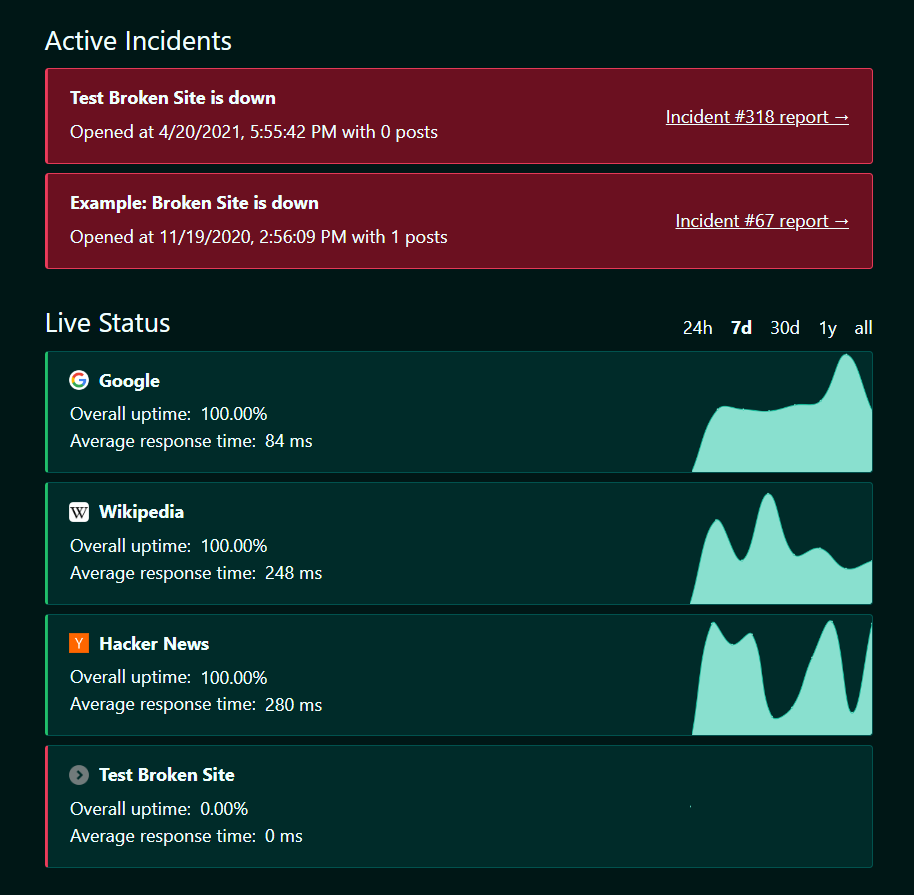
Key Features
- Actions-powered uptime monitor: Utilizes Actions to schedule workflows for automatic monitoring every 5 minutes, ensuring websites are up and running.
- Issues for incident reports: Automatically opens new issues in the repository when a specified endpoint goes down, allowing users to add information about the outage and manage incident reports.
- Pages for status website: Utilizes Pages to create the status website, providing a sleek and modern interface for displaying website uptime and performance statistics.
Pricing
The pricing for Upptime is free since it is an open-source project.
Pros
- Cost-effective solution for website monitoring
- A modern and efficient approach to website monitoring
- Sleek and beautiful interface
Cons
- Dependency on GitHub actions for monitoring
- Lack of detailed reports
- Requires technical skills for setup and maintenance
3. Vigil
Vigil is an open-source monitoring tool that helps users monitor their infrastructure and services. It is designed to be lightweight, easy to use, and highly customizable.
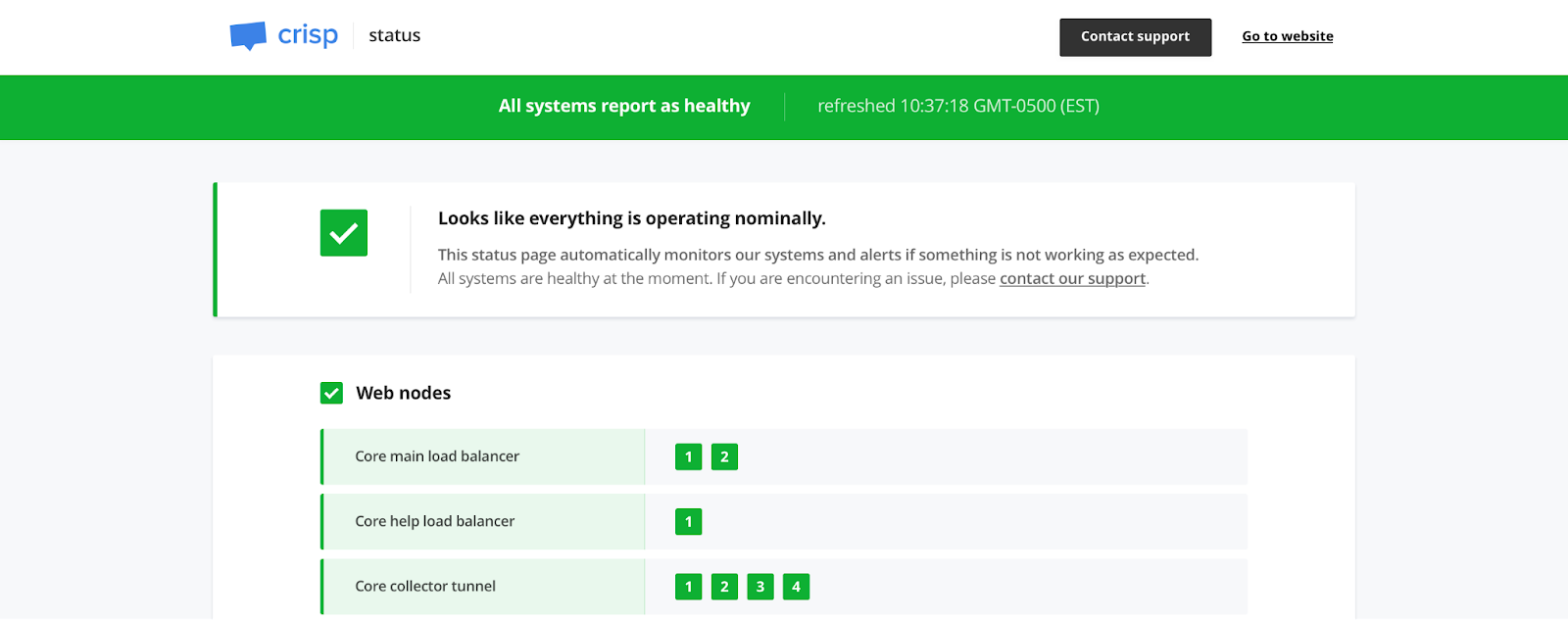
Key Features
- Infrastructure monitoring: Vigil monitors your infrastructure and services, ensuring that they are up and running.
- Highly customizable: Vigil is highly customizable, allowing users to define the services to monitor and the alerting rules to apply using a simple configuration file.
- Open-source: Vigil is an open-source project, that provides a cost-effective solution for monitoring infrastructure and services.
Pricing
- Starter: This plan is available at $1.99 per month. It offers basic features and is suitable for users with minimal requirements.
- Basic: Priced at $4.99 per month, the Basic plan provides additional features and benefits compared to the Starter plan. It is ideal for users who need more functionality.
- Professional: At $9.99 per month, the Professional plan offers advanced features and enhanced capabilities. It is designed for users who require a higher level of performance and customization.
- Business: The Business plan is priced at $24.99 per month. It includes all the features of the previous plans, along with additional benefits tailored for businesses with complex needs.
Pros
- Cost-effective
- Customizable
- Remote surveillance monitoring
Cons
- Limited support
- Limited integrations
4. Statping
Statping is an easy-to-use, open-source software for monitoring websites, services, APIs, and applications. It offers a simple setup process, monitoring capabilities, graphs and analytics, and is available as a Docker image, making it a versatile and accessible monitoring solution for users with various monitoring needs.
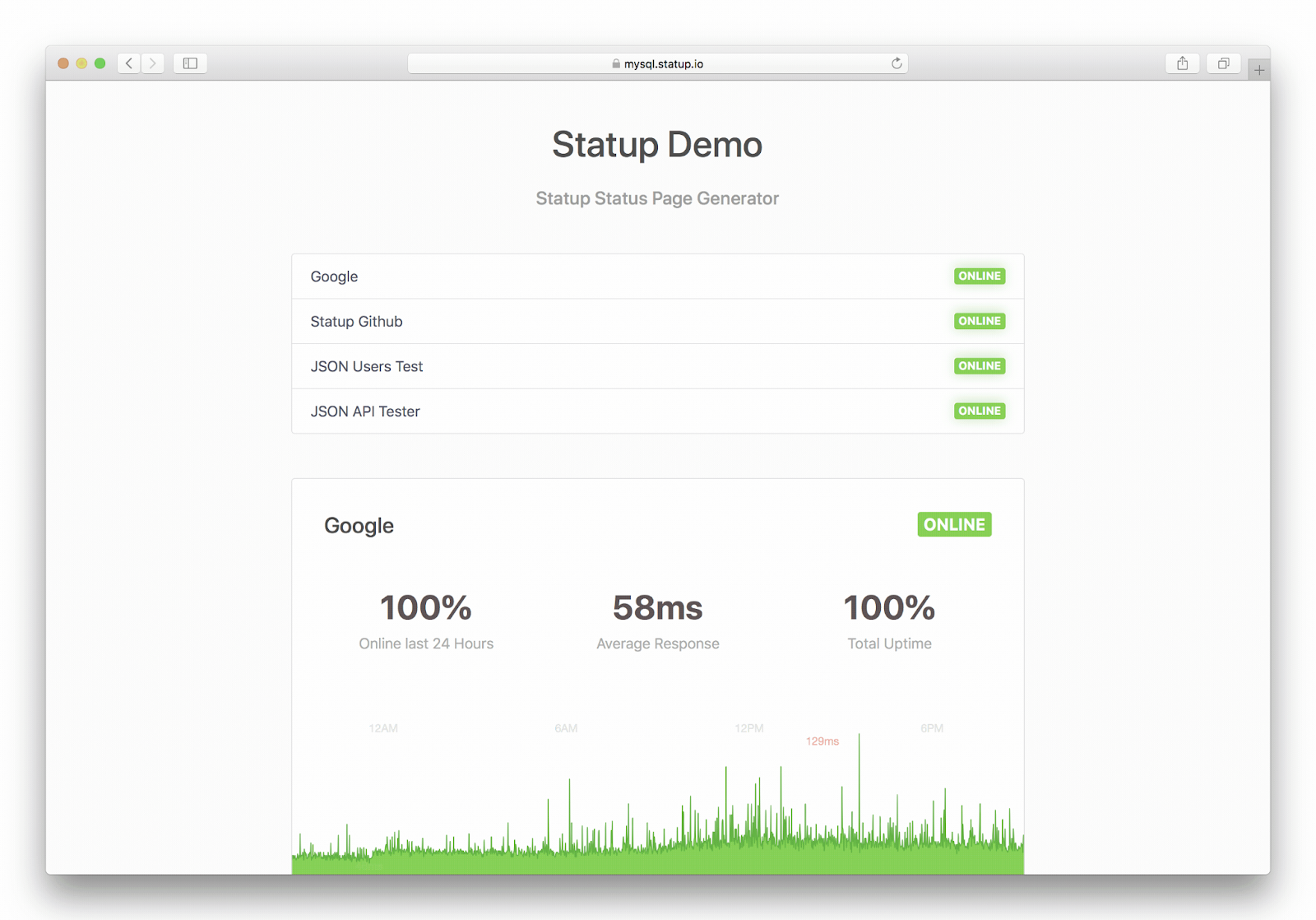
Key Features
- Graphs and analytics: Statping offers features like graphs, analytics, and plugins, providing users with valuable insights into the performance of their monitored entities.
- Professional monitoring solution: According to a Reddit post, Statping has significantly more features and is considered more of a professional monitoring solution than a hobbyist project.
- Docker image: Statping is available as a Docker image, making it easy to deploy and manage within a containerized environment.
Pricing
The pricing information for Statping is not explicitly mentioned in the provided sources. However, it is stated that the server runs on the smallest EC2 instance (t2.nano) AWS has to offer, which only costs around USD 4.60 a month for a dedicated Status Page. Specific pricing plans or tiers are not explicitly outlined.
Pros
- Easy to set up, requiring no fussing with dependencies or packages
- Highly customizable
- Offers a mobile app for both iOS and Android
Cons
- Users have reported issues with the Statping mobile app, including bugs and a white screen
- Issues with the original Statping project and concerns about its development and maintenance
5. UptimeRobot
UptimeRobot is a comprehensive and user-friendly website monitoring service that offers essential features such as multi-site monitoring, SSL monitoring, location insights, real-time alerts, and detailed reporting.
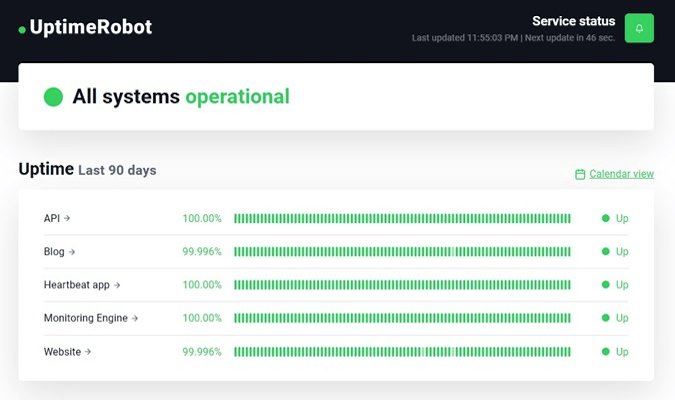
Key Features
- Multi-site monitoring: Simultaneously monitors various websites, servers, and online services for enhanced oversight.
- SSL monitoring: Checks SSL certificates for expiration and security issues.
- Location insights: Offers valuable insights into performance fluctuations across different global monitoring locations.
- Maintenance windows: Allows users to schedule maintenance windows for their websites and servers.
- Custom HTTP requests: Offers the ability to send custom HTTP requests for monitoring specific endpoints or services.
Pricing

- Free: The free plan includes 50 monitors with 5-minute monitoring intervals.
- Solo: The solo plan costs $8 per month or $84 per year and includes 10 monitors with 1-minute monitoring intervals.
- Team: The team plan costs $34 per month or $348 per year and includes 50 monitors with 1-minute monitoring intervals.
- Enterprise: The enterprise plan costs $64 per month or $648 per year and includes 100 monitors with 30-second monitoring intervals.
Pros
- The free option provides essential features
- Seamless integrations
- Real-time alerts
Cons
- Less responsive customer support
- Inability to reset stats for monitoring checks
6. Monitoror
Monitoror is a unified monitoring wallboard app that allows users to monitor server status, CI builds progress, and critical values.
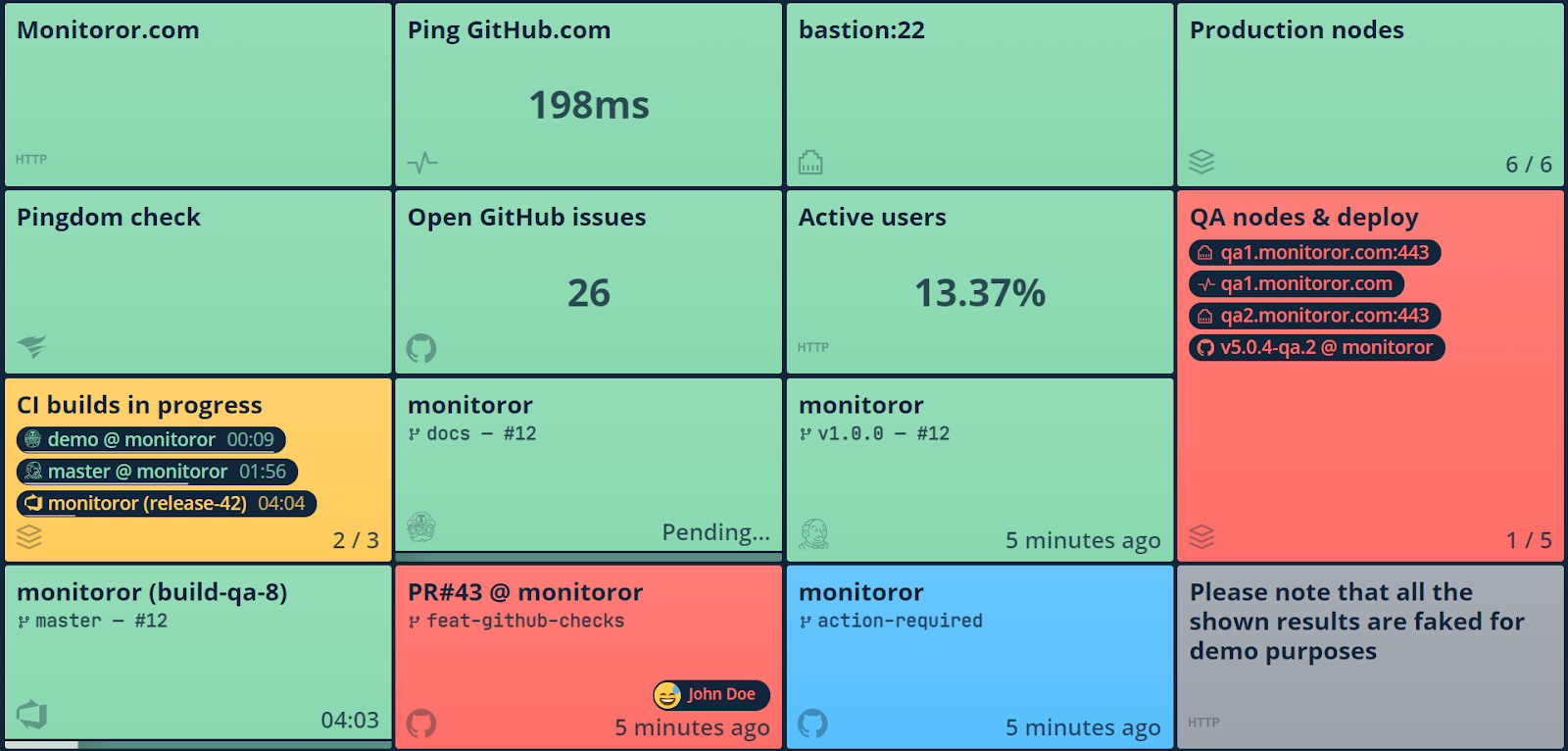
Key Features
- Customization: Users have the ability to customize the UI and configuration of the Monitoror to fit their specific needs.
- Reliability: Monitoror is described as reliable and ergonomic, providing a fast and efficient solution for monitoring.
- Free to download: Monitoror is free to download, providing a cost-effective monitoring solution.
Pricing
Based on the provided sources, Monitoror is a free platform available for download on the Monitoror website. It offers versions for Linux x64, Linux ARM, Windows x64, and macOS.
Pros
- Unified monitoring
- Ease of use
- Free to download
Cons
- Limited integrations
- Limited documentation and support
7. Cachet
Cachet is an open-source status page system that is freely available for self-hosting. As an open-source project, Cachet is available for download and use without any cost.
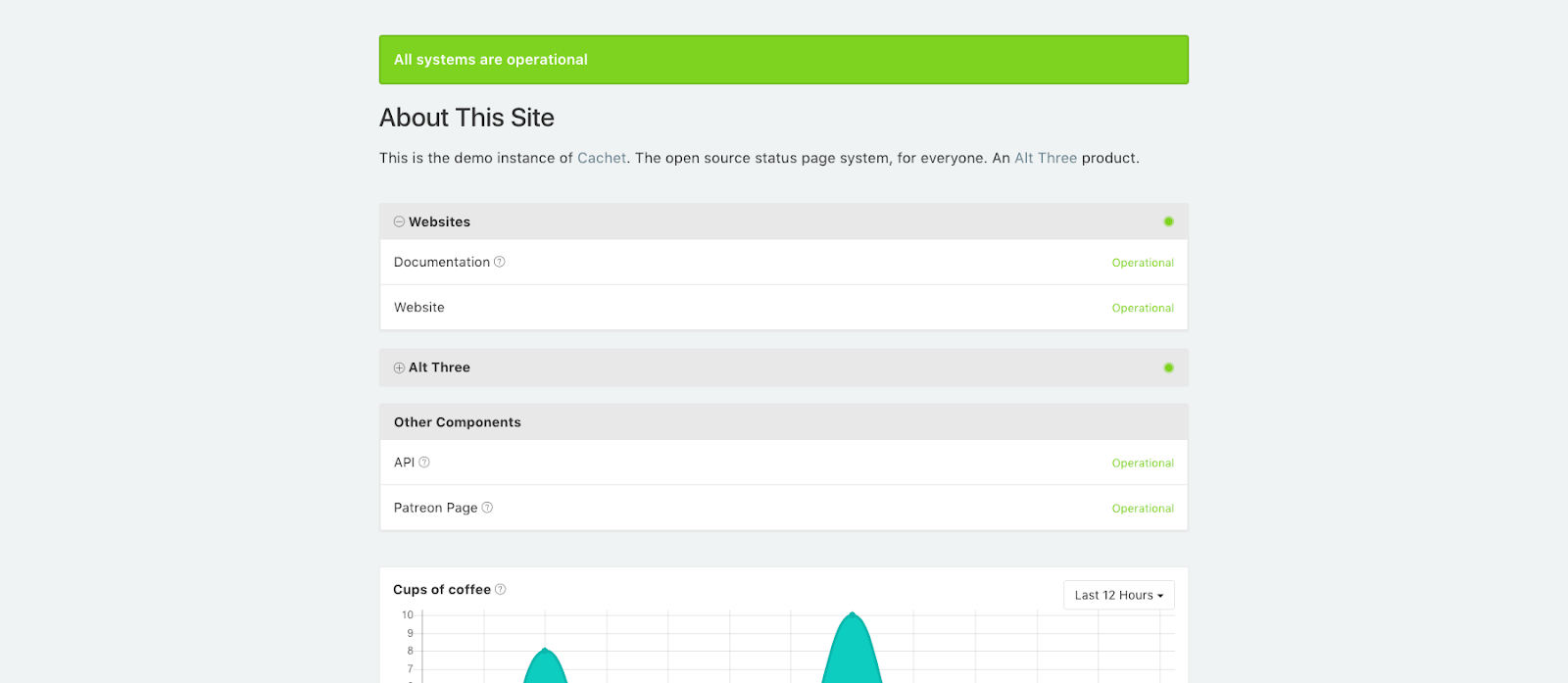
Key Features
- JSON API: Cachet is bundled with a simple, but powerful, JSON API for updating the status page with incidents and component status changes.
- Scheduled maintenance: Cachet allows users to schedule maintenance events ahead of time and seamlessly move incidents into the timeline for record-keeping and future reference.
- Metrics: Users can set up metrics within the dashboard to measure uptime, error rates, or other relevant data.
- Two-factor authentication: The platform provides two-factor authentication for an additional layer of security.
Pricing
- Free: Cachet is available for free, allowing users to self-host the platform and use it for their monitoring needs.
- Professional Installations: Cachet offers professional installation services for businesses, ensuring a smooth and timely setup process.

Pros
- Open-source
- Responsive design
- Audience-specific status
Cons
- Limited customization
- Requires technical knowledge
- No built-in alert system
8. cState
A comprehensive and customizable status page system for organizations of all sizes. Maintain transparency with users, especially during downtime or maintenance.
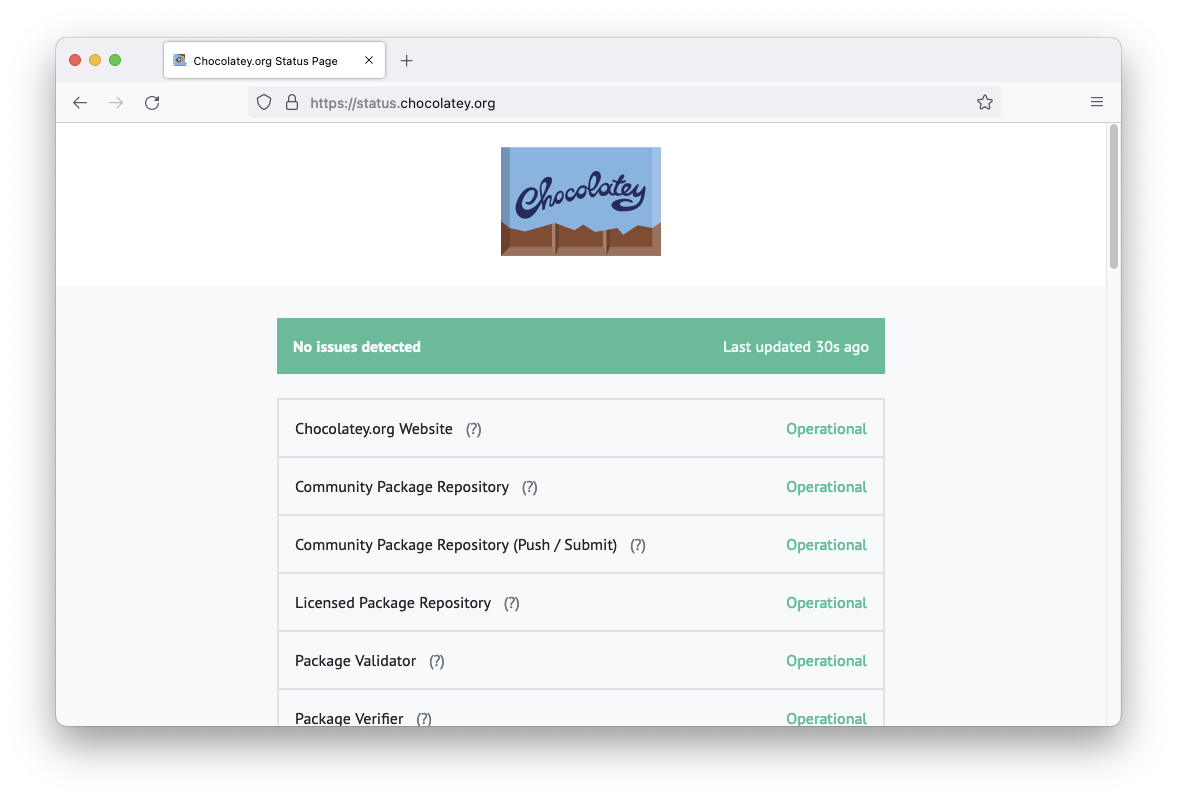
Key Features
- Adaptable design: cState offers a focused and adaptable design that can be customized easily from one file or settings page.
- Statistical calculations: cState provides statistical calculations that show the key takeaways, such as the time spent fixing an issue.
- Multi-lingual support: cState offers built-in support for multiple languages, including English, German, French, Italian, Lithuanian, Macedonian, Dutch, Portuguese, Turkish, and Tagalog.
Pricing
The pricing of cState is free unless users require additional features or support.
Pros
- Open-source status page system
- Tailored status pages for specific audiences
- Supports sharing sensitive info with authorized personnel
Cons
- Time-consuming, with complex patterns
Conclusion
Whether you're searching for a feature-rich page monitoring solution, even during downtimes, or simply seeking an alternative to Uptime Kuma, Instatus is here to cater to your needs. It goes beyond being just a status page; it's a powerful and visually appealing platform that empowers you to proactively monitor and address any issues before they impact your customers.
This guide aims to assist you in selecting the perfect Uptime Kuma alternative that suits your requirements.
If you're ready to elevate your status page, explore Instatus today!
Get ready for downtime
Monitor your services
Fix incidents with your team
Share your status with customers

